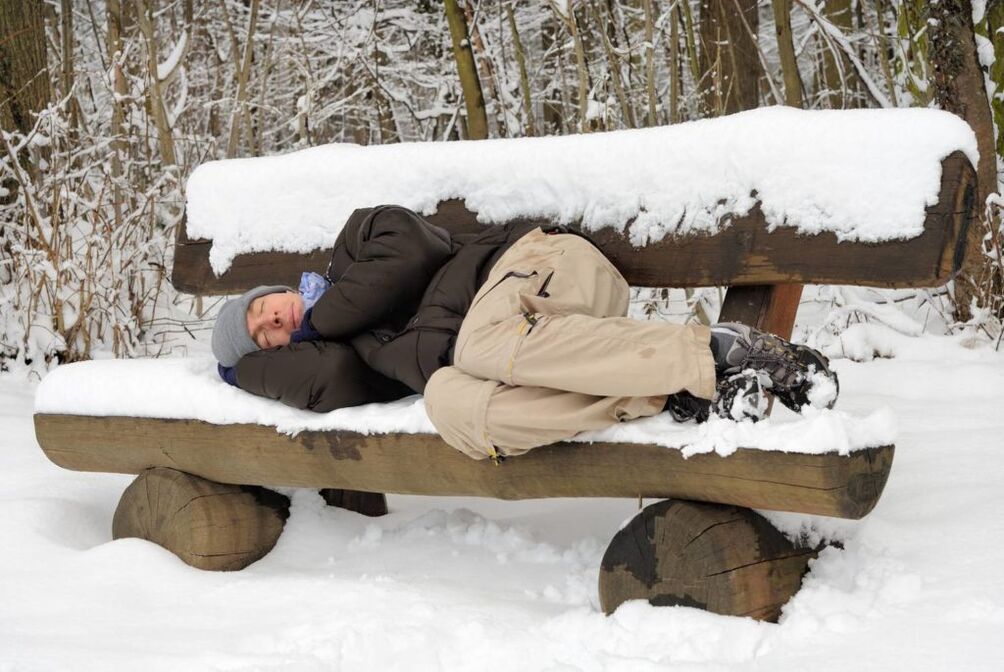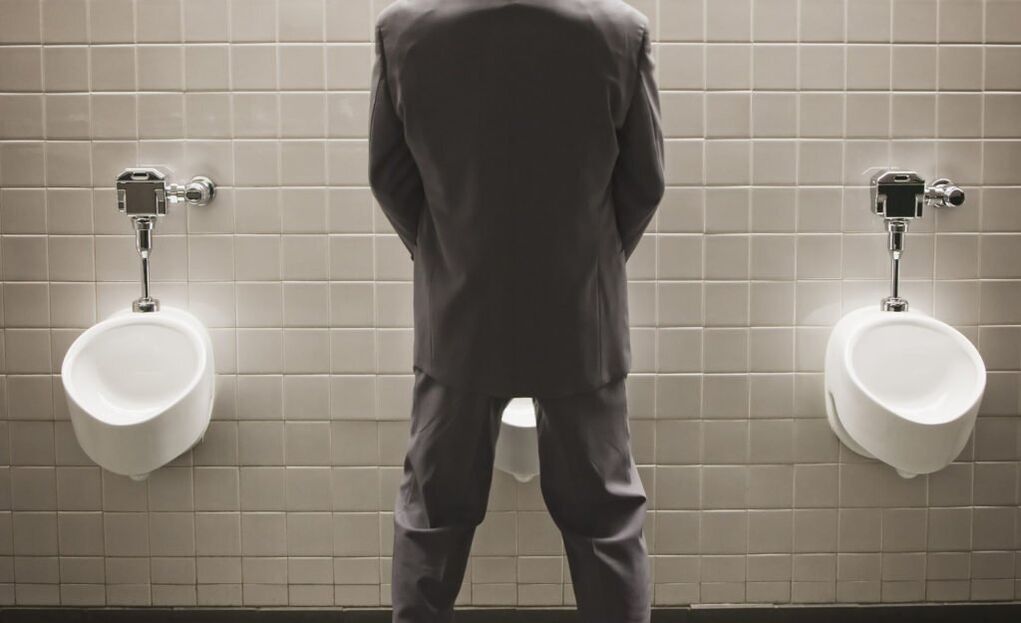Prostatitis is a dangerous, but unfortunately very common disease of the male genitourinary system. Previously, the disease occurred mainly in elderly men, today urologists are increasingly diagnosing this disease in young patients. Every man who cares about his health should know what types of prostatitis there are and how it manifests itself.
Causes of the development of prostatitis

Acute hypothermia of the prostate is the most "sure" way to get prostatitis.
Prostatitis is an inflammation of the prostate gland. This disease must be diagnosed and treated in time, otherwise serious consequences are possible.
The causes of this disease are divided into two large groups - infectious and non-infectious. Infectious causes of this disease include:
- opportunistic pathogens that are always present in the human body;
- mushrooms;
- sexually transmitted bacteria;
- viruses;
- mycobacteria.
Opportunistic pathogens of this disease are Escherichia coli and Pseudomonas aeruginosa, because most infectious prostatitis is caused by these pathogens. They enter the prostate from the gastrointestinal tract by blood or lymph movement. Also, the disease can occur as a result of penetration of pyogenic bacteria (pneumococcus, staphylococcus) through the urethra or hematogenously.
The fungi that cause prostatitis are most often yeast microflora of the genus Candida. Infection with this fungus can occur sexually, but Candida is an important part of the normal human microflora, so it can enter the prostate from other organs and systems. Fungal prostatitis is rarely caused by molds.
Inflammation of the prostate can be caused by syphilis, gonorrhea, chlamydia and other infections transmitted during unprotected sex.
In rare cases, viruses are the cause of the disease. Thus, prostatitis can develop against the background of influenza or SARS, when the virus spreads throughout the body through the bloodstream. Prostate tuberculosis is isolated separately. This is a dangerous disease associated with infection of the body with Koch bacillus, the causative agent of tuberculosis.
Non-infectious causes of inflammation of the prostate gland:
- stagnation of prostate secretion;
- disruption of blood circulation and lymph flow from the pelvic organs;
- genital hypothermia;
- Varicose veins.
In general, non-infectious prostatitis is often called the "disease of office workers" because its development is directly related to physical inactivity.
Risk factors

If earlier the main risk group for the development of this disease was men over 50 years old, today there are more risk factors, so young men aged 23-25 are increasingly facing prostatitis. The risk of developing inflammation of the prostate gland increases due to:
- lack of regular sex life;
- sedentary work and hypodynamia;
- endocrine disorders;
- hormonal disorders;
- hypothermia;
- stress;
- nutrition;
- bad habits;
- unprotected connection.
Lack of sex life is the main enemy of the prostate gland. But at the same time too intense sexual life also damages this organ. If, with long-term abstinence, stagnation of prostate secretions during ejaculation can be caused, a rich sexual life exhausts the prostate gland and thereby leads to the development of prostatitis.
The male body needs regular physical activity. Otherwise, the blood circulation of the pelvic organs deteriorates, which leads to swelling of the prostate gland and disruption of tissue trophism of the organ, and this, in turn, is the main reason for the development of non-infectious inflammation. prostate.
Risk factors include reduced immunity, sexual dysfunction, and various diseases of the genitourinary system that can be a potential source of infection.
Classification of prostatitis
To understand what prostatitis is, first of all, the classification of diseases will help. However, it is not recommended to diagnose yourself by describing the symptoms. At the first signs of concern, you should consult a urologist. It is important to understand that different types of prostatitis manifest themselves in different ways, but all of them pose a threat to men's health if not treated in time.
Regardless of the form of prostatitis, treatment should begin as soon as possible. Early diagnosis and timely therapy is a chance to get rid of the disease without the risk of complications within a few weeks.
Prostatitis is classified according to the nature of inflammation and the degree of involvement of prostate tissue in the pathological process. Each form of the disease has specific symptoms that are revealed during the examination. Thus, the results of the analysis of prostate secretion, which should be performed by all men with suspected inflammation of the prostate, will provide complete information about the type of disease.
What is acute prostatitis?

Before considering the specific forms of the inflammatory process in the prostate, it is necessary to understand what prostatitis is by the nature of the course. There are two main forms - acute and chronic inflammation.
Acute prostatitis is a rapidly spreading inflammation of the prostate gland. It is often a disease caused by any pathogen. However, the non-infectious form of the disease can also occur in an acute form, for example, during the initial manifestation.
Acute prostatitis is characterized by bright symptoms. Men complain of severe urinary disorders, severe pains spreading to the perineum, lower back, and anus. Anxiety increases when trying to urinate and ejaculate.
Features of chronic prostatitis
The chronic form of the disease is caused by acute prostatitis. This type of prostatitis in men has less noticeable symptoms and is primarily associated with the lack of treatment or inadequate therapy for acute prostatitis. Pathology is characterized by slow inflammation that can sometimes worsen.
Symptoms of the disease: weak urine flow, slow erection, weak arousal. In chronic prostatitis, the desire to go to the toilet increases at night, during defecation, he feels discomfort in the prostate gland, manifests itself as a feeling of squeezing or bursting of the organ.
With hypothermia or reduced immunity, symptoms intensify, pain and spasms appear in the bladder, and the urge to go to the toilet becomes more frequent.
Bacterial prostatitis: features and symptoms
One of the most common types of the disease is bacterial prostatitis. It is caused by the penetration of various bacteria into the prostate gland. Often, the causative agent is Escherichia or Pseudomonas aeruginosa or other opportunistic bacteria living in the human body.
The main reasons for its development are reduced immunity, severe stress, smoking and other conditions that weaken the body.
Bacterial prostatitis manifests itself with the following symptoms:
- pain and pain during urination associated with irritation of the urethra by bacteria penetrating the prostate gland;
- high body temperature;
- signs of general intoxication: nausea, dizziness, weakness;
- pain in the perineum;
- blood in the urine.
This form of the disease progresses rapidly and can lead to prostate abscess. When the first symptoms appear, you should immediately make an appointment with a specialist.
Infectious prostatitis
It is called infectious prostatitis caused by bacteria, fungi, viruses. In fact, bacterial prostatitis is a type of infectious inflammation. This type of pathology has the same symptoms as bacterial inflammation.
The infectious form of the disease can occur in acute and chronic form. As a rule, the chronic form of the disease develops due to complications of the acute inflammatory process or improper treatment.
Viral prostatitis

Acute respiratory viral infection can serve as a catalyst for the development of viral prostatitis
The most dangerous and poorly studied form of infectious prostatitis is viral inflammation. It can be the cause of herpes, human papillomavirus, measles, rubella, flu. Often, inflammation of the prostate gland occurs against the background of the spread of the causative agent of common SARS.
The problem of viral prostatitis is that antibiotic therapy is ineffective, and antiviral agents do not penetrate well into the tissues of the prostate gland.
As a result, a long course of therapy with antiviral agents and immunomodulators is required, after which the disease is likely to become chronic, and the treatment is continued with other drugs. This form of prostatitis often causes infertility at a young age.
Fungal prostatitis
This is a rare form of the disease caused by a fungus of the genus Candida. The main feature of this type of inflammation is the almost complete absence of symptoms at the initial stage. Thus, fungal prostatitis does not manifest itself in an acute form, it immediately turns into a chronic disease.
Purulent prostatitis
This is the most severe and dangerous form of infectious inflammation caused by pyogenic bacteria. The pathology continues in an acute form, it is manifested by high body temperature and the release of purulent masses from the urethra. The disease can lead to an abscess of the prostate gland, which requires immediate hospitalization and surgical intervention, otherwise the abscess can rupture and become infected with purulent masses of blood.
Calculated form of inflammation
Stones or stones may form in the prostate gland. These are deposits of phosphates and calcifications in the walls of the body. Calculus irritates the prostate tissue, causing an inflammatory reaction. This form of the disease is characterized by blood in the urine and sharp pain during defecation due to the movement of salt deposits due to muscle tension and damage to the tissue of the prostate gland. This form of the disease is experienced by elderly men. In addition, calculous prostatitis is considered a complication of untreated congestive prostatitis in men.
Diagnostics

After understanding the types of prostatitis in men and the symptoms of different types of inflammation, it becomes clear that the diagnosis should be made only by a specialist. At the first signs of the disease, it is necessary to consult a urologist and undergo examinations. To make a diagnosis, palpation of the prostate, analysis of prostate secretion, and ultrasound examination of the body are performed.
The cause of inflammation is determined by the composition of prostate juice, its consistency and quantity. An ultrasound examination is performed to rule out calculous prostatitis. Based on the results of these tests, the diagnosis is made and the optimal treatment regimen is determined.
Treatment of inflammation
Signs and symptoms of prostatitis depend on the type of disease. Treatment is selected individually for each patient, depending on the nature of the inflammatory process. In general, all bacterial inflammatory processes are treated with broad-spectrum antibiotics with antimicrobial activity. Antiviral drugs and drugs that strengthen the immune defense are used to treat viral disease. The fungal form of the disease requires the use of special drugs - antimycotics.
So-called prostate biostimulators are used to eliminate non-infectious inflammation. These are drugs that improve tissue trophism of the inflamed organ, dilute prostate secretion and stimulate its release. These drugs improve the functions of the body.
In addition, symptomatic treatment is prescribed. In the acute form of the disease, non-steroidal anti-inflammatory drugs are used, which relieves pain and temperature. If a man has serious problems with urination, drugs that relax the muscles of the bladder and urethra - alpha-blockers are used.
In addition, herbal diuretics, suppositories that improve blood circulation in the gland, anti-inflammatory drugs with natural ingredients and other drug groups are used.
It is important to remember that self-medication can cause great harm to health. Drug therapy should be prescribed only by the attending physician.
How to prevent the development of the disease?

To prevent the disease, you should undergo regular medical examination.
Prevention of prostatitis is an urgent issue for all men. For a healthy prostate you need:
- treat all diseases in time;
- always dress for the weather and avoid genital hypothermia;
- take care of your health and use contraception;
- lead an active lifestyle;
- To do exercise;
- give up bad habits;
- eat right.
For prevention, all men are advised to consume pumpkin seeds in small quantities, as this product is a natural prostate protector.
Also, all men over the age of 40 should see a urologist every year, even if they have no complaints.






























